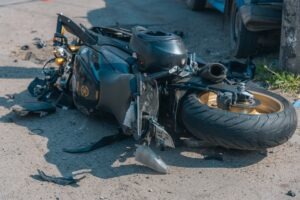
Riders are found at fault in roughly 30% to 40% of motorcycle accidents involving other vehicles, based on data from national transportation studies and state crash reports. In most multi-vehicle collisions, the other driver is more likely to be responsible—often due to failure to yield, distraction, or impaired driving.
Despite common stereotypes that paint riders as reckless, most crashes involving motorcycles are caused by drivers of larger vehicles. Still, when a motorcyclist makes a critical error, the consequences can be severe. Fault matters not only for crash prevention but also for Davie motorcycle accident lawyers in determining who can recover damages in a legal claim.
Understanding How Fault Is Determined
Determining fault after a motorcycle crash isn’t always straightforward. Investigators review multiple factors to assess who caused or contributed to the accident. Key elements used to determine fault include:
- Police crash reports and witness statements
- Traffic camera or dashcam footage
- Vehicle positioning and skid marks at the scene
- Traffic violations, such as failure to yield or speeding
Insurance companies will also conduct their own evaluations, often with the goal of reducing payouts. That’s why it’s important for riders to collect evidence early, including photos, contact information from witnesses, and documentation of the road and weather conditions. With the proper evidence, a Davie personal injury lawyer can better prepare your case.
Common Scenarios Where the Rider Is at Fault
Although riders are not usually the primary cause of multi-vehicle crashes, there are certain behaviors that increase their share of liability. We’ve seen riders held at fault in cases involving:
- Speeding: Exceeding the posted limit or traveling too fast for conditions
- Weaving between lanes or riding on lane dividers
- Running red lights or stop signs
- Riding under the influence of drugs or alcohol
- Sudden braking or unsafe overtaking
Some of these behaviors result from inexperience, while others may be split-second decisions made to avoid hazards. Regardless of intent, these actions can significantly impact legal outcomes.
When the Other Driver Is to Blame
In most motorcycle crashes involving a passenger vehicle, the driver of the car or truck is at fault. Motorcycles are smaller and less visible, and drivers often make assumptions or mistakes that put riders in danger. The most common driver errors we encounter include:
- Failing to yield to motorcycles at intersections
- Turning left in front of oncoming riders
- Following too closely, leading to rear-end collisions
- Distracted driving, including texting or using navigation systems
- Impaired driving, which dulls reaction times and judgment
We often find that drivers fail to account for a motorcycle’s position or speed, particularly at intersections where visibility is reduced. These moments of inattention or miscalculation frequently lead to deadly outcomes.
How Shared Fault Affects Compensation
If a motorcyclist is partially at fault, it doesn’t automatically prevent them from recovering damages—but it can reduce the total amount they’re eligible to receive. Under Florida’s current law, HB 837, compensation is reduced in proportion to the rider’s level of fault. However, if they’re found 51% or more at fault, they may be barred from recovery entirely.
That’s why detailed accident reconstruction and legal guidance are critical. Without a clear breakdown of who caused what, riders risk being unfairly blamed—and undercompensated—for a crash they didn’t fully cause.
Why Fault Is So Often Misassigned
Motorcyclists are sometimes unfairly blamed for accidents due to stereotypes or assumptions. Drivers, police officers, and even insurance adjusters may jump to conclusions based on a rider’s appearance, speed, or bike type—especially in cases involving sport bikes or loud pipes.
This bias makes it even more important to investigate thoroughly and present objective facts:
- Was the rider obeying speed limits and traffic laws?
- Did the other driver truly see the motorcycle before merging or turning?
- Were road conditions or visibility a factor?
Motorcyclists deserve the same fair and impartial treatment that any driver would expect, and establishing the facts clearly is critical to securing that fairness.
A Motorcycle Accident Lawyer Can Help Prove the Truth
Proving fault in a motorcycle accident takes more than just a police report. A skilled motorcycle accident lawyer can work with crash reconstruction experts, subpoena traffic camera footage, and gather physical evidence to build a stronger case.
In fatal accidents, this becomes even more important for surviving family members who may be pursuing a wrongful death claim. Knowing how to interpret evidence and present it in negotiations or court is often the key to recovering fair compensation.
Having legal support early in the process can also prevent insurance companies from shifting blame or undervaluing the claim—especially when the rider is not able to speak for themselves.
Get Legal Help After a Motorcycle Crash
At Winston Law Firm, we fight for injured riders and families facing the aftermath of serious or fatal motorcycle accidents. We’ve built our reputation on aggressive representation and personal commitment to every case we take on.
Our founding attorney, Bradley Winston, was invited to join the American Council of Motorcycle Attorneys—a national group of leading trial lawyers dedicated to motorcycle advocacy.
When we take your case, we investigate every detail, challenge false assumptions, and push back against insurance companies that try to shift blame.
If you’ve been injured in a crash—or lost a loved one—you deserve to know the truth and pursue justice. Contact us today or check out our free ebooks, the Florida Motorcycle Accident Bible and Five Deadly Sins that Can Wreck Your Injury Claim.

